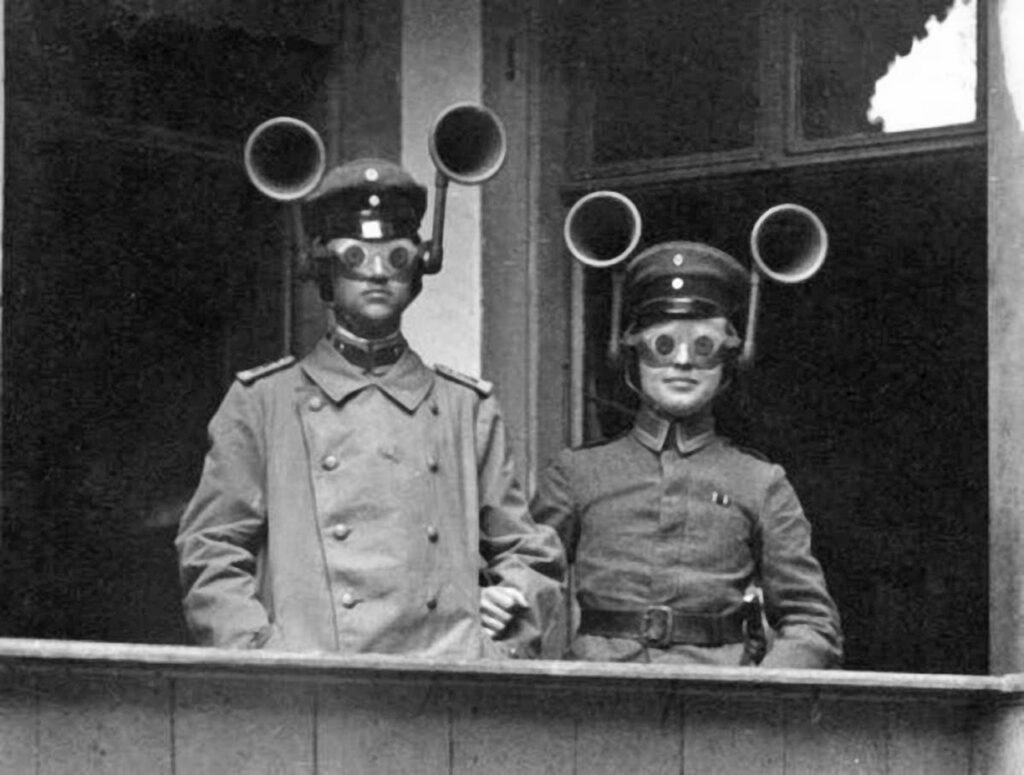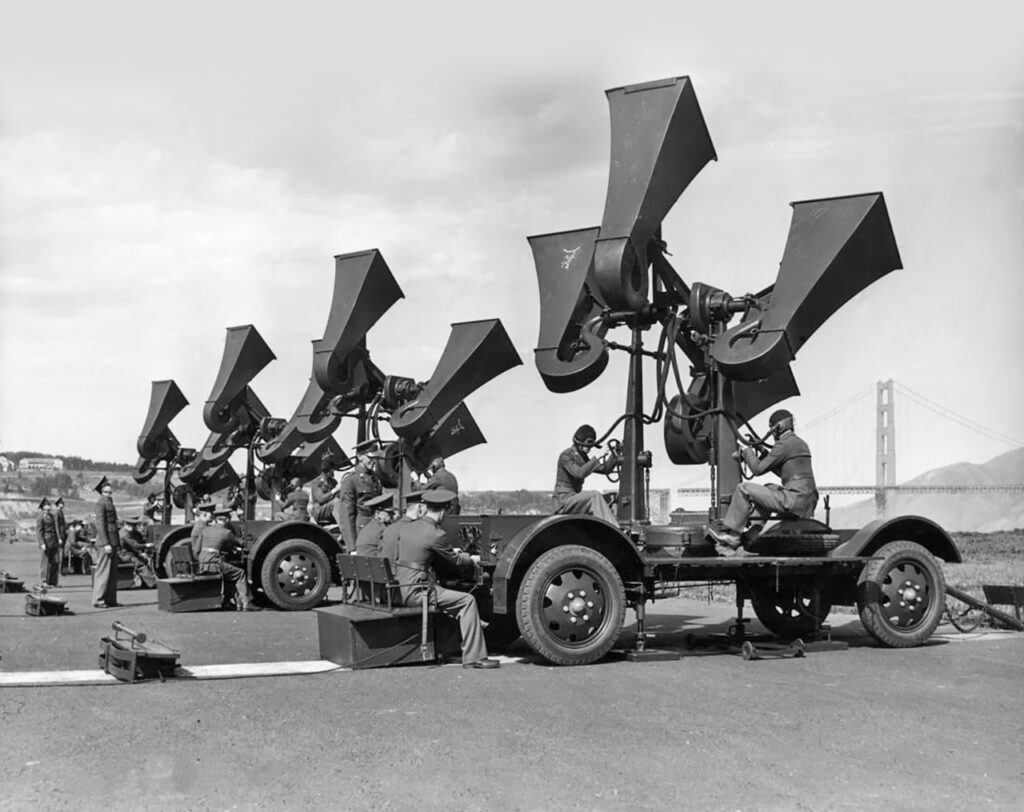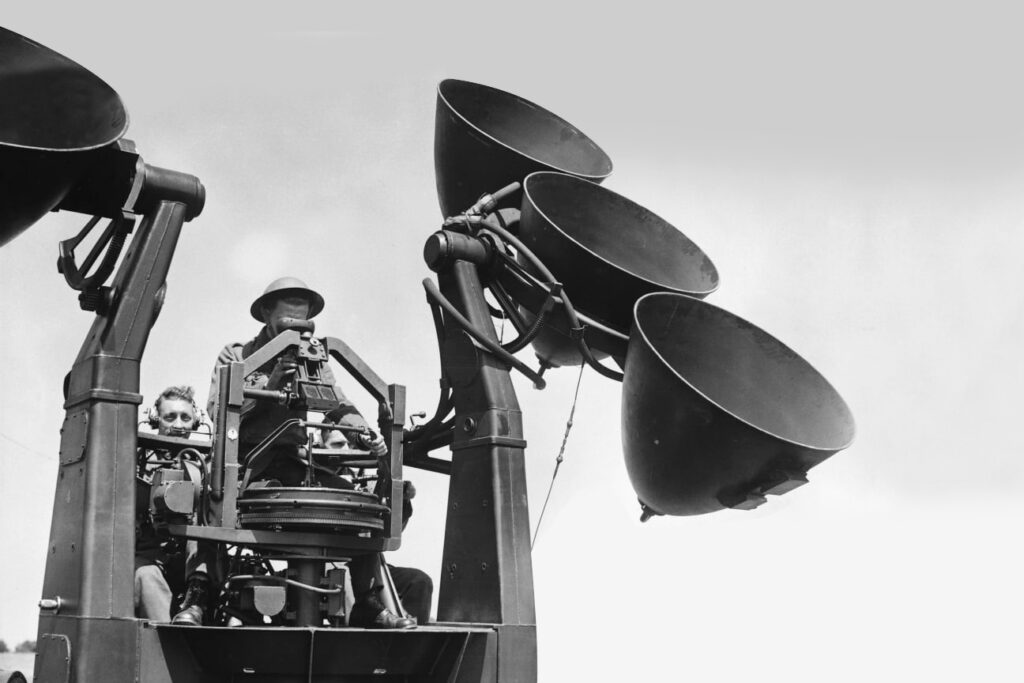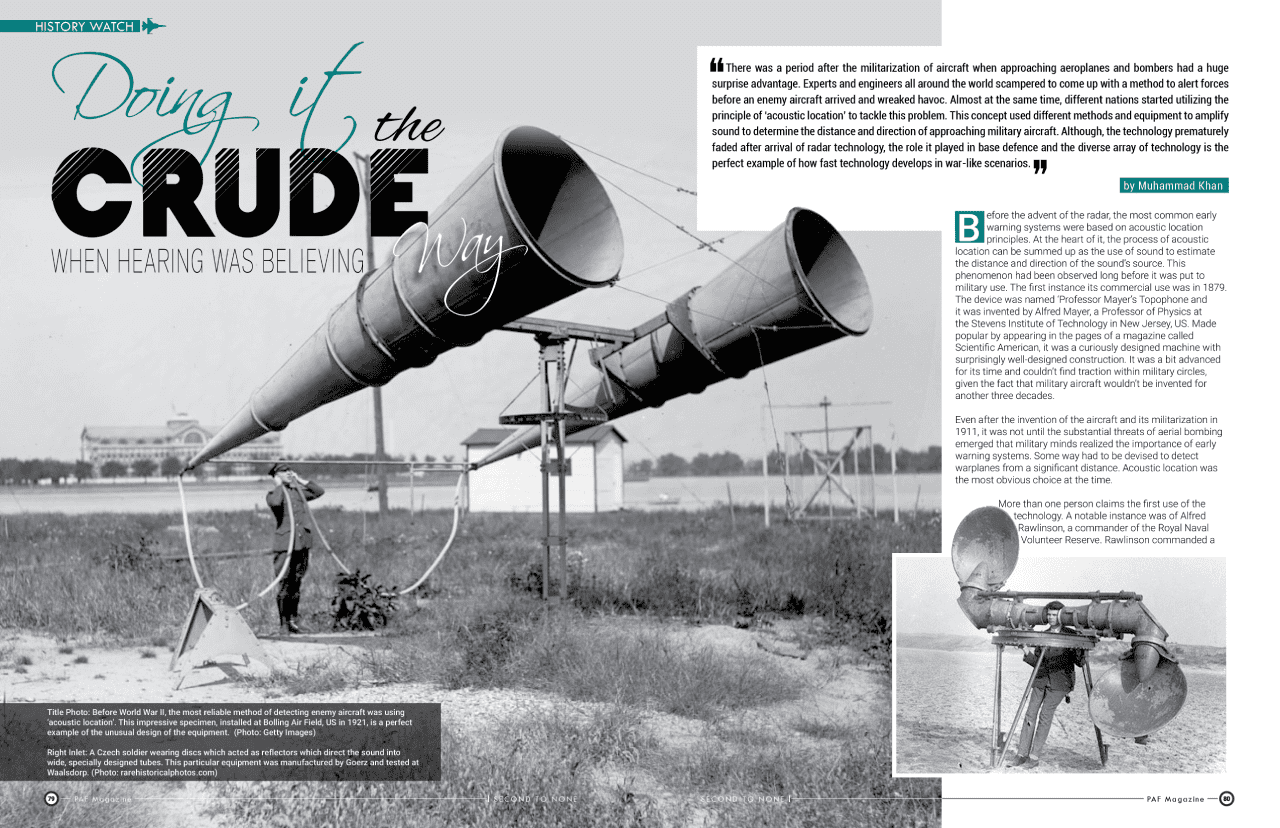When Hearing was believing
There was a period after the militarization of aircraft when approaching aeroplanes and bombers had a huge surprise advantage. Experts and engineers all around the world scampered to come up with a method to alert forces before an enemy aircraft arrived and wreaked havoc. Almost at the same time, different nations started utilizing the principle of ‘acoustic location’ to tackle this problem. This concept used different methods and equipment to amplify sound to determine the distance and direction of approaching military aircraft. Although, the technology prematurely faded after arrival of radar technology, the role it played in base defence and the diverse array of technology is the perfect example of how fast technology develops in war-like scenarios.
Before the advent of the radar, the most common early warning systems were based on acoustic location principles. At the heart of it, the process of acoustic location can be summed up as the use of sound to estimate the distance and direction of the sound’s source. This phenomenon had been observed long before it was put to military use. The first instance its commercial use was in 1879.
The device was named ‘Professor Mayer’s Topophone and it was invented by Alfred Mayer, a Professor of Physics at the Stevens Institute of Technology in New Jersey, US. Made popular by appearing in the pages of a magazine called Scientific American, it was a curiously designed machine with surprisingly well-designed construction. It was a bit advanced for its time and couldn’t find traction within military circles, given the fact that military aircraft wouldn’t be invented for another three decades.
Even after the invention of the aircraft and its militarization in 1911, it was not until the substantial threats of aerial bombing emerged that military minds realized the importance of early warning systems. Some way had to be devised to detect warplanes from a significant distance. Acoustic location was the most obvious choice at the time.
More than one person claims the first use of the technology. A notable instance was of Alfred Rawlinson, a commander of the Royal Naval Volunteer Reserve. Rawlinson commanded a mobile anti-aircraft battery on the east coast of England in 1916. A problem persistent to the crew was the overcast sky in the area. Clouds would hinder their vision, making it hard to see the approaching Zeppelins. Rawlinson, in an epiphany of improvisation, decided to construct a device which could potentially help them determine the location of the incoming aircraft even if they did not have a visual on it. The device was a pair of gramophone horns fixed on a rotating pipe. From each of the horns, a tube was connected which was then used to hear any incoming sounds. It was essentially a bloated, amplified stethoscope. This equipment gave successful results, giving mostly accurate fixes on approaching aircraft, even though they weren’t visible through the clouds. Although no planes were shot down using these equipment, Rawlinson claimed to have forced one of the Zeppelins to jettison its bombs at one point.
Sound Mirrors:

Another pioneer of location determination using acoustics was Dr. William Sansome Tucker of Britain. Dr. Tucker used the same principles of acoustic location but his application was different. He came up with the idea of ‘sound mirrors’ in 1915. Sound mirrors were large, concave discs made of concrete. The concept was similar to the modern TV receiver, replacing radio waves with sound waves and was the cutting-edge innovation in military research on sound and its wartime uses. They worked by using the curved design to amplify sounds and noise by capturing the sound of any incoming aircraft from the European mainland. This technique was amplified by using a human listener with advanced stethoscopes. After the receiver was calibrated for optimum reception, the captured noise would be matched with the data received from the other receivers. The comparison would, then, be used to calculate speed, flight path and height. The most effective range for the mirrors was from 8 to 24 miles. The operator/listener stationed at the acoustic mirror was given special training so he distinguish between different sounds and noises. It was a difficult task, sometimes so much so that the listeners could not perform it for more than 40 minutes. Later, special microphones were designed by Dr. Sansome which were placed at the focus point of every sound mirror. This made the structures much more effective.
The mirrors ranged from 20ft to 200 ft, most of which are still intact and can even be visited today. From 1915 to 1935, the British army built several acoustic mirrors around its coastal areas. These mirrors proved to be useful and warned the forces of approaching war planes by the distant sound of their engines. The system could detect the engine sounds of the German bombers from almost 15 miles away. This meant that the British forces could detect aircraft coming in about 15 minutes before they actually got there. This gave the British almost enough time to ready their artillery, if they were vigilant.
The mirrors are sturdy structures and still stand today at various locations throughout Britain. The best specimens, however, are the ones constructed on the Dungeness peninsula and at Hythe in Kent. In the Dungeness peninsula, there are 3 acoustic mirrors which stand till today. The biggest of them is a 70 metres long curved wall, with a height of about 5 metres. Sound mirrors were eventually rendered obsolete by the advent of the radar but Dr. William Sansome had given us the mechanism to use connected systems to accurately pinpoint the location of an aircraft. This mechanism made substantial contributions to the technology that followed.
The addition of sound mics designed by Dr. Sansome also gave rise to another way to use acoustic location. Listening Wells were deep shafts or holes, which were effective in picking up sound waves that other designs couldn’t. Listening Wells, although effective, were very rudimentary in use. The operators had to spend hours on end, constricted in a hole deep underground. These wells were only constructed in Romney Marsh in England.

This wasn’t the only use of acoustic location at the time. Several other militaries were making use of the same principle in their own unique fashions. Although, radar technology was on the horizon, these machines had to fill the gaps till they were widely available.
In the late 1930s, Hitler’s forces were on the rise once again. It was obvious that to build a formidable military defence, the Nazis would need fool-proof anti-aircraft measures. The British had made significant advancement on the radar technology but the Germans were not far behind. They did, however, have advanced acoustic location technology, the prime example of which was the ‘Das Ringtrichterrichtungshoerer’, which can be translated to ‘ring-horn acoustic direction detector’. This technology was successfully used to assist searchlight operators locate night bombers.
The Americans used the technology adequately, as well. They used different versions of acoustic locators. A good specimen was a substantially large, fixed 2-horn listening device installed at Bolling Field in Washington, D.C. The devices eventually became less cumbersome and mobile but they were rendered obsolete soon afterwards. An important part that acoustic locators played in American military history was detecting the first Japanese aircraft coming in to attack the American-occupied island of Corregidor in 1941.
The Mechanism:
The acoustic locators were designed on the design of the human ear. Pinna is the outer ear, the part that we normally see. The pinna is specifically designed to capture sound and amplify them. These augmented sound waves then enter the inner ear, where sensitive organs process them. If you cup your hand over your outer ear, you will instantly feel the difference in that ear. Your ear will capture sound waves more effectively. Acoustic location works on the same principle, enhancing the outer ear by giving it a major boost in ability. They usually consisted of large horns or microphones connected to the operators’ ears using tubing, much like a very large stethoscope. Most acoustic location devices use this principle, in their own unique way.

The trumpet or tuba shaped designs, which looked like warped versions of their musical counter-parts, consisted of several horns to capture sound waves from afar. The horns were usually arranged in horizonal and vertical configurations. The horizontal horns could pinpoint the incoming aircraft’s bearing and the vertical horns were used to estimate the height of the aircraft, using triangulation. If the device was moveable, the operator would tilt and move the device until he received the loudest sound waves.
In the case of sound mirrors, the mirrors were usually immovable discs of concrete standing at larger heights. The disc would catch sound from afar, being faced the direction that it was, and it would be amplified by the microphone installed in front of it. Sound mirrors had a much farther range than the sound trumpets or horns but required extensive construction. They could easily detect an aircraft from 10 to 15 miles away. This meant that if a combat aircraft was travelling around 60 mph, it gave the troops 15 minutes warning before it reached their destination.
It is said that the Germans figured out the fact that their enemies were using acoustic location devices to counter their aircraft. They came up with a an idea to counter this. Aircraft engines are usually run synchronized to reduce vibration. The Germans ran the engines of their bombers unsynchronized in the hope that it might make the aircraft harder to detect.
The next step after microphones, in 1939, were systems that stopped relying on sound completely and interpreted the noise in terms visual symbols which were displayed on a cathode ray tube screen. This device was developed by Alan Blumlein.
The demise of acoustic location:
Acoustic location devices were elementary anti-aircraft measures to start with, providing only a weak defence. As technology progressed, the increasing speeds of aircraft meant that the warning time given by the device was significantly lessened, which meant that the operators had almost no time to act before the aircraft arrived. The last nail in the coffin for acoustic locators was the advent of radar technology. Although, the devices kept on being used by multiple militaries, it was just a matter of radar technology being available.
However, it is pertinent to say that the research and application of acoustic location had far-reaching benefits. The acoustic mirror programme, the brainchild of Dr. William Sansome Tucker, had provided England the mechanics to use interconnected stations to accurately locate the exact position of an adversary in the sky. The mechanics he developed connected the stations and plotted the trajectory of the aircraft which were then used to accurately determine the position of the aircraft. This research was then handed over to the early radar team and it made a substantial difference in their efforts which eventually culminated to the invention of the radar.









